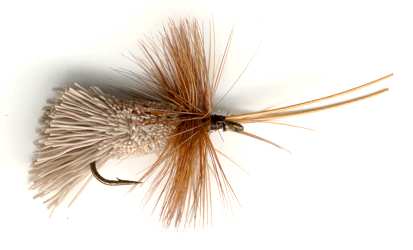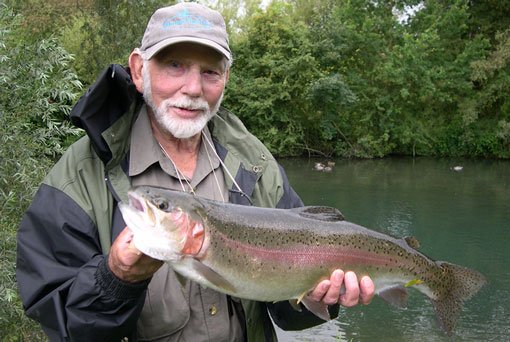Goddard's Gray Caddis (G & H Sedge) Fly
The Goddard's Gray caddis with clipped hair body work great on fast water over big rocks where higher flotation and visibility is important. It also works well on quieter water,

GODDARD'S CADDIS FLY PATTERNS. Hook size 10 12 14 16 18 - $US each - Great for rough water
The trout looking up at the surface recognize the silhouetted shape of the clipped Goddard's Caddis as that of the natural caddis. On bright sunny days fishing on water that is reflecting the sunshine it can get difficult keeping track of your fly. Use a White Goddard's Caddis. If the sun goes in try a more natural colored Goddard’s caddis to match the local hatch like this on.
Originally this caddis imitation was called the 'G & H Sedge' (John Goddard & Cliff Henry sedge) and still is in Britain. Sedge is another name for Caddis. It was designed by the fly fishing entomologists Mr John Goddard and Mr Cliff Henry after they had observed and studied the silhouette of caddis flies as they skittered invitingly over the water's surface during the later part of the day. They wound buoyant deerhair onto a hook and then sculptured the material until it matched the insect's wing and body shape. They ended up with a nearly unsinkable fly that when retrieved on the water surface produced a realistic wake. The trout loved it. It was a radical design when it was first published in fly fishing magazines and pattern books. To understand the design of this Caddis fly you need to know a little of the natural history of the caddis. When the caddis hatch the emergent adult tries to swim as fast as it can to the safety of the bank. In this mad dash for survival it creates a 'V' shaped wake a bit like a small speed boat. The trout are on the look out for this give away sign of fast food on the move and home in on these flies with some spectacular takes. The blunt stubby wings that copy the shape of the natural insects's wing cause a disturbance on the retrieve, in the water surface that mimics that caused by the scuttering adults.

This is fly fisherman John Goddard designer of the Goddard's Caddis (G and H Sedge)
Goddard's Caddis flies are not the answer to all your rising fish fly fishing situations. When the trout are sipping little blue winged olives from the water surface they will often ignore a large floating Goddard's. But during quiet periods without any major hatch underway the Goddard's Caddis is a great searching fly for drawing strikes from larger than average trout. The versatility of this fly is the key to its success. Fished dead-drifted over a rising trout will often draw a strike, but when this does not work the high floating characteristics means it can be skated, twitched or otherwise worked on the surface to get a response. Sometimes these tactics can draw slashing strikes from large fish as big trout hammer the fly with the same gusto of a big bass taking a surface deerhair popper.
I like to fish these flies down and across the stream. I use a reach-casting and then slack line technique to avid drag. When the line tightens in the current I twitch the fly briefly and then lower the rod tip to create slack and the momentary dead drift of the fly as if it is resting. I dress both fly and leader with floatant. The leader must be floating along with the fly or your twitches will drag the fly under. Sometimes I only dress the fly with floatant. The leader tippet sinks drawing the fly under when it is twitched. If you give it some slack at this point the deer hair will bob quickly back up to the surface in an action trout find irresistible. The Goddard's Caddis's extreme buoyancy means that it also works well as a strike indicator

CUSTOMER'S PHOTO
Dear Craig, I was fishing every day since Saturday. I have to test your flies <grin> Today I
caught a beautiful brown trout with the Goddard’s gray caddis fly. It was a great fight. 39 cm. Greeting from Austria with wonderful fishers weather. Tomorrow I will go again, Raffaela, Kössen, Austria
LINKEDIN COMMENT
Here in New Zealand most of my Caddis fishing is done just on dark. I would normally fish a mayfly up to 30 to 45 minutes before dark. every thing often goes quiet them. I change to an adult Caddis like a Goddard but tie a short 30 cm leader off the bend of the fly and attach an emerger. The dry (adult) acts as indicator and has been a consistent Technic for me during the change from Mayfly to Caddis. As soon as there is a lot of surface action I know the fish have moved off the emerger so I simply cut the trace at the bend of the dry and continue to fish the hatch. - Pat Swift
FACEBOOK READER'S COMMENT
I am the proud owner of box of john Goddard's original patterns tied by John himself. He was a great designer of flies but a bloody untidy tier. Most of his flies were tied for him by his great friend and fishing buddy John Smith of Woking, who coincidentally is a member of the Surrey (UK) branch of the fly Dressers Guild of which I am chairman. Christopher Reeves


Goddard's fishing books

